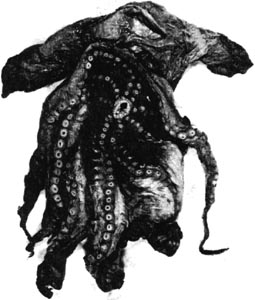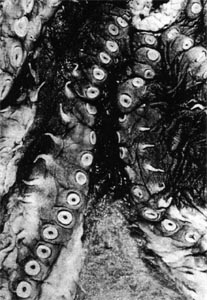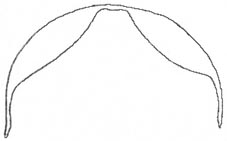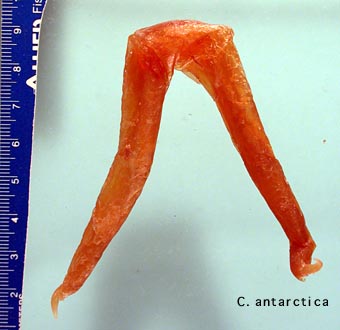Cirroctopus antarctica
Michael Vecchione and Richard E. YoungIntroduction
Cirroctopus antarctica was described from two octopods and is known only from these animals.Characteristics
- Shell
Kubodera and Okutani (1986) describe the shell as follows: "The [shell] is broadly U-shaped. both rami, particularly at postero-lateral portion, are widened The posteriormost connective of both rami seems to be weaker than the remaining area." The original drawing is seen below and a recent photograph of the same shell is seen on the right.
- Pigmentation
The title photographs suggests that the oral surface of C. antarctica has the same odd pigmentation as C. glacialis.
- Measurements and counts
Measurements and counts to the left of the semicolon are from Kubodera and Okutani (1986) and those to the right of the semicolon are from O'Shea (1999).Characters: Measurements in mm Holotype Paratype Sex ? Female Mantle length 91; 94 180 Mantle width 95; 69 135 Head width 45 100 Fin length 80; 67 70 Fin width 40; 30 33 Lengths and counts Left/Right Left/Right Arms I 200/200; 232/245 310/300 Arms II 220/220; 253/255 310/280 Arms III 225/220; 235/231 320/350 Arms IV 220/215; 236/230 300/260 Web sector A 110 140 Web sector B 105/95 160/160 Web sector C 110/100 150/160 Web sector D 110/105 160/155 Web sector E 55 110 Arm I sucker counts (right; left/right) 72; 55/65 76 Arm II sucker counts 73; 64/64 73 Arm III sucker counts 69; 58/65 78 Arm IV sucker counts 73; 55/63 55+
Comments
Kubodera and Okutani stated that this species differed from C. mawsoni by having subequal arms (this character would also separates it from all other members of the genus which have distinctly shorter ventral arms). The two octopods in the type series of C. antarctica were not in good condition and arm measurements can be very inaccurate. Arm size, however, remains a possible distinguishing character. The authors state that this species differs from C. glacialis by the shell which is very broad in posterolateral regions and the "well chitinized" beak. There appears to be no real difference in beak chitinization. The shell, however, does pose a problem. A photograph (see above) of the same gladius no longer, at least, appears to be distinctive as originally described but does seem to differ in some respects to the shell of C. glacialis (see that page). Unfortunately the degree of variation of the shell in both species is unknown. O'Shea (1999) considered this species to be a probable synonym of C. glacialis. We suspect that he is correct.
Distribution
Type locality: 62° 59'S, 62° 09'W, 804 m depth. The paratype was collected at 61° 23'S, 55° 11'W, 509-525 m depth.References
Kubodera, T. and T. Okutani. 1986. New and Rare Cephalopods from the Antarctic Waters. Memoirs of National Institute of Polar Research, Special Issue, 44:129-143.
O’Shea, Steve. 1999. The Marine Fauna of New Zealand: Octopoda (Mollusca: Cephalopoda). NIWA Biodiversity Memoir 112: 280pp.
Vecchione, M., U. Piatkowski and A. L. Allcock. 1998. Biology of the cirrate octopod Grimpoteuthis glacialis (Cephalopoda; Opisthoteuthidae) in the South Shetland Islands, Antarctica. S. Afr. J. Mar. Sci. 20: 421-428.
About This Page

National Museum of Natural History, Washington, D. C. , USA

University of Hawaii, Honolulu, HI, USA
Page copyright © 2016 and
 Page: Tree of Life
Cirroctopus antarctica .
Authored by
Michael Vecchione and Richard E. Young.
The TEXT of this page is licensed under the
Creative Commons Attribution-NonCommercial License - Version 3.0. Note that images and other media
featured on this page are each governed by their own license, and they may or may not be available
for reuse. Click on an image or a media link to access the media data window, which provides the
relevant licensing information. For the general terms and conditions of ToL material reuse and
redistribution, please see the Tree of Life Copyright
Policies.
Page: Tree of Life
Cirroctopus antarctica .
Authored by
Michael Vecchione and Richard E. Young.
The TEXT of this page is licensed under the
Creative Commons Attribution-NonCommercial License - Version 3.0. Note that images and other media
featured on this page are each governed by their own license, and they may or may not be available
for reuse. Click on an image or a media link to access the media data window, which provides the
relevant licensing information. For the general terms and conditions of ToL material reuse and
redistribution, please see the Tree of Life Copyright
Policies.
- First online 13 May 2003
- Content changed 27 February 2016
Citing this page:
Vecchione, Michael and Richard E. Young. 2016. Cirroctopus antarctica . Version 27 February 2016 (under construction). http://tolweb.org/Cirroctopus_antarctica/20108/2016.02.27 in The Tree of Life Web Project, http://tolweb.org/













 Go to quick links
Go to quick search
Go to navigation for this section of the ToL site
Go to detailed links for the ToL site
Go to quick links
Go to quick search
Go to navigation for this section of the ToL site
Go to detailed links for the ToL site